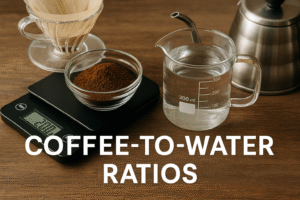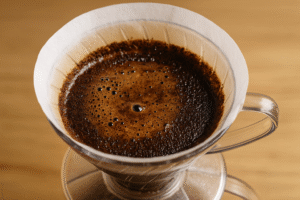The Moka Pot, also known as a stovetop espresso maker, is a beloved tool in many kitchens around the world. It brews strong, rich coffee that closely resembles espresso without needing a pricey machine.
Invented in Italy in the 1930s, the Moka Pot has become iconic for its unique shape and intense coffee. If you enjoy bold flavors and low-acid coffee, learning how to use a Moka Pot can change your mornings.
Let’s dive into a step-by-step guide to brewing perfect coffee with this small but mighty device.
What Is a Moka Pot and How Does It Work?
A Moka Pot uses steam pressure to push hot water through finely ground coffee. It has three main parts: a bottom chamber (for water), a filter basket (for coffee), and a top chamber (for the brewed coffee).
When heated, steam builds in the lower chamber. The pressure pushes water upward through the coffee grounds and into the top compartment.
While it doesn’t reach the same pressure as an espresso machine, it creates a concentrated brew with bold body and rich flavor.
What You Need to Get Started
To make coffee with a Moka Pot, you’ll need:
- A clean Moka Pot (any size)
- Fresh, finely ground coffee (slightly coarser than espresso)
- Hot water
- A stove or heat source
- A spoon and scale (optional)
- A mug or serving cup
Using fresh, quality beans is essential. A medium to dark roast works best in this method.
Step-by-Step: Brewing Coffee in a Moka Pot
1. Preheat Water
Start by heating water in a kettle. This prevents the coffee grounds from overheating and becoming bitter during brewing.
Fill the bottom chamber of the Moka Pot with hot water up to the safety valve.
Avoid overfilling—it can cause excessive pressure and impact brewing.
2. Add Coffee to the Filter Basket
Fill the basket with ground coffee. Level it off without pressing or tamping the grounds.
Tamping will block water flow and create uneven extraction. A gentle tap to settle the grounds is enough.
Place the basket into the base with the water.
3. Assemble the Moka Pot
Carefully screw the top part of the pot onto the base. Use a towel if the base is hot.
Make sure the seal is tight to prevent leaks, but don’t over-tighten. That can wear out the gasket over time.
4. Place on Medium Heat
Put the Moka Pot on the stove over medium heat with the lid open.
As the water heats, pressure builds and pushes the coffee through the filter and into the top chamber.
You’ll hear a hissing or bubbling sound as the coffee begins to flow.
5. Watch and Remove from Heat
Once the stream of coffee slows and you hear a gurgling sound, the brewing is done.
Remove the pot from heat immediately to avoid burning the coffee.
Close the lid and let it settle for a few seconds before serving.
How to Serve Moka Pot Coffee
Moka coffee is intense and concentrated. Serve it as is for a bold espresso-like shot, or dilute it with hot water for an “Americano” style drink.
You can also add steamed milk for a homemade latte or cappuccino experience.
Pair it with pastries or toast for a traditional Italian breakfast.
Tips for Better Results
- Grind Matters: Use coffee that’s slightly coarser than espresso. Too fine, and it clogs the filter; too coarse, and it tastes weak.
- Water Temperature: Starting with hot water avoids burning the coffee as the base heats up.
- Don’t Overfill: Follow water level markings and avoid covering the safety valve.
- Clean After Use: Rinse all parts with warm water and avoid soap—it can affect flavor over time.
- Don’t Leave Coffee Sitting: Transfer coffee to another container if not drinking immediately to avoid over-extraction.
Common Mistakes to Avoid
- Using cold water: This makes the Moka Pot sit longer on heat, over-extracting the coffee and creating bitterness.
- Tamping the grounds: This increases pressure and may lead to clogging.
- Overheating the pot: Always use medium heat and remove as soon as brewing finishes.
- Letting it boil too long: This leads to burnt, metallic-tasting coffee.
- Using the wrong grind size: An improper grind is the most common cause of weak or overly bitter coffee.
Why Choose the Moka Pot?
The Moka Pot is affordable, compact, and durable. It’s ideal for small kitchens, travel, or anyone wanting espresso-style coffee without the machine.
It offers full-bodied flavor, flexibility, and that satisfying sound when the brew finishes.
Plus, it’s a great introduction to pressure-based coffee methods.
Frequently Asked Questions (FAQs)
1. Can I use Moka Pot coffee for espresso drinks?
Yes! While it’s not true espresso, it’s strong enough for lattes, cappuccinos, and flat whites. Just steam your milk separately.
2. Can I use pre-ground coffee?
You can, but fresh ground is better. If you use pre-ground, make sure it’s not too fine, like powdery espresso blends.
3. Is it safe to leave the Moka Pot unattended?
No. Always watch it while brewing. Overheating can cause the coffee to burn or boil over.
4. How do I know if the coffee is done?
You’ll hear a sharp hissing or gurgling sound when the brewing finishes. That’s your signal to remove it from the stove.
5. Can I wash it with soap?
It’s best to rinse with warm water only. Soap can leave residue and affect flavor in future brews.
6. How often should I replace the gasket?
Inspect the rubber gasket every few months. If it’s cracked, stiff, or leaks, replace it. Most gaskets last 6–12 months with daily use.
7. Can I make cold brew or tea in a Moka Pot?
No. The Moka Pot is designed specifically for brewing coffee with pressure and heat.
Final Thoughts – Mastering the Art of the Moka Pot
Using a Moka Pot isn’t just about making coffee—it’s a ritual. From the smell of the grounds to the bubbling finish, each step adds to the experience.
With a little attention to detail and some practice, anyone can make bold, rich coffee with this traditional tool.
It’s proof that great coffee doesn’t require expensive machines—just good technique and quality beans.
So next time you crave a strong cup, skip the café line and reach for your Moka Pot.

Marcio Luzardo is a coffee enthusiast and the voice behind Tudo Viraliza. With a passion for turning curiosity into practical knowledge, he shares easy-to-follow tips, guides, and insights to help readers enjoy better coffee every day. When he’s not writing, Marcio is exploring new brewing methods or diving into the rich stories that connect coffee to culture, lifestyle, and wellness.



